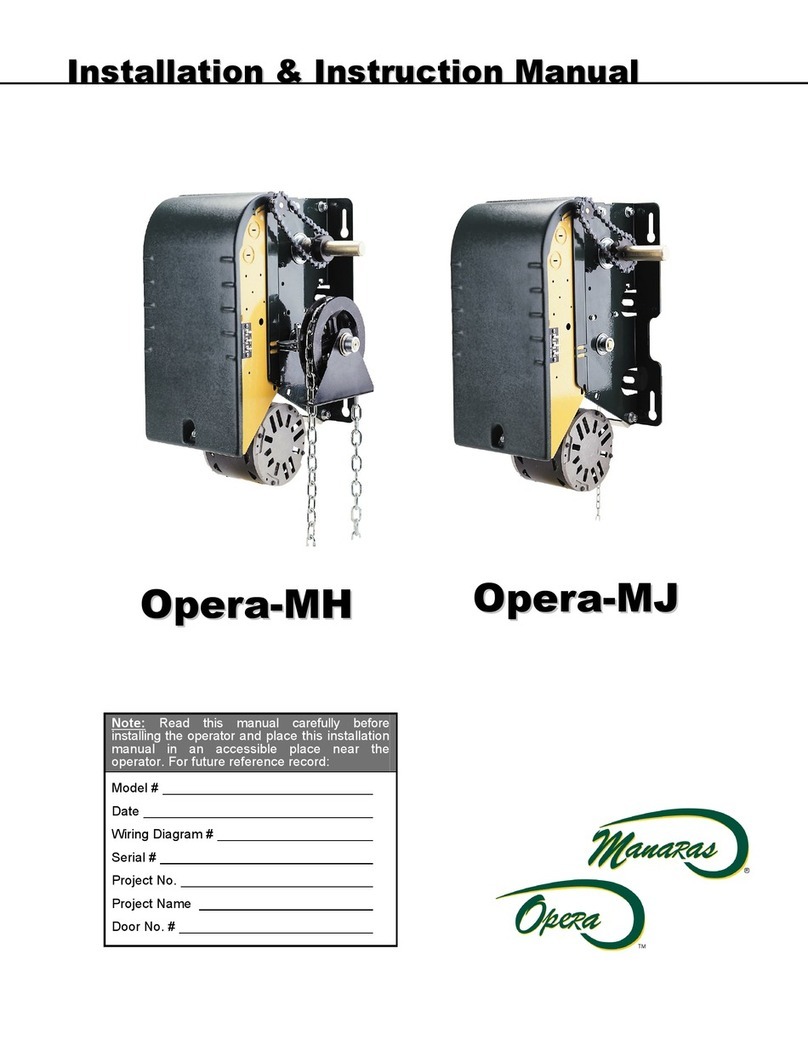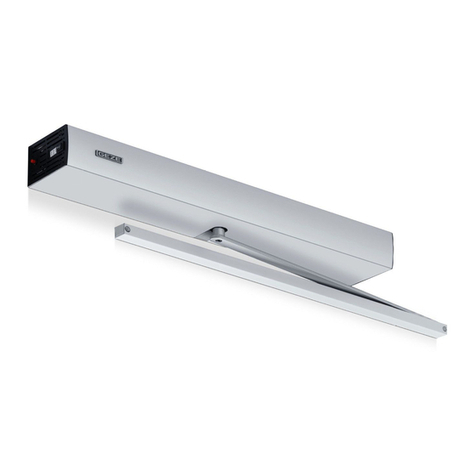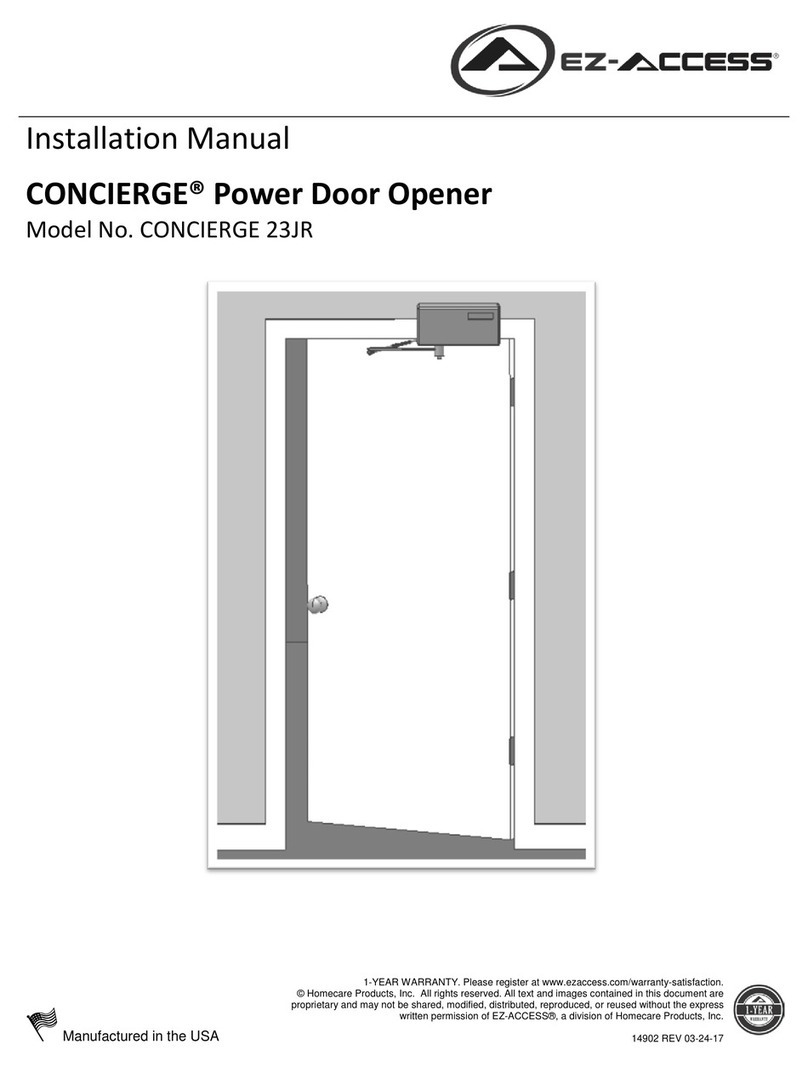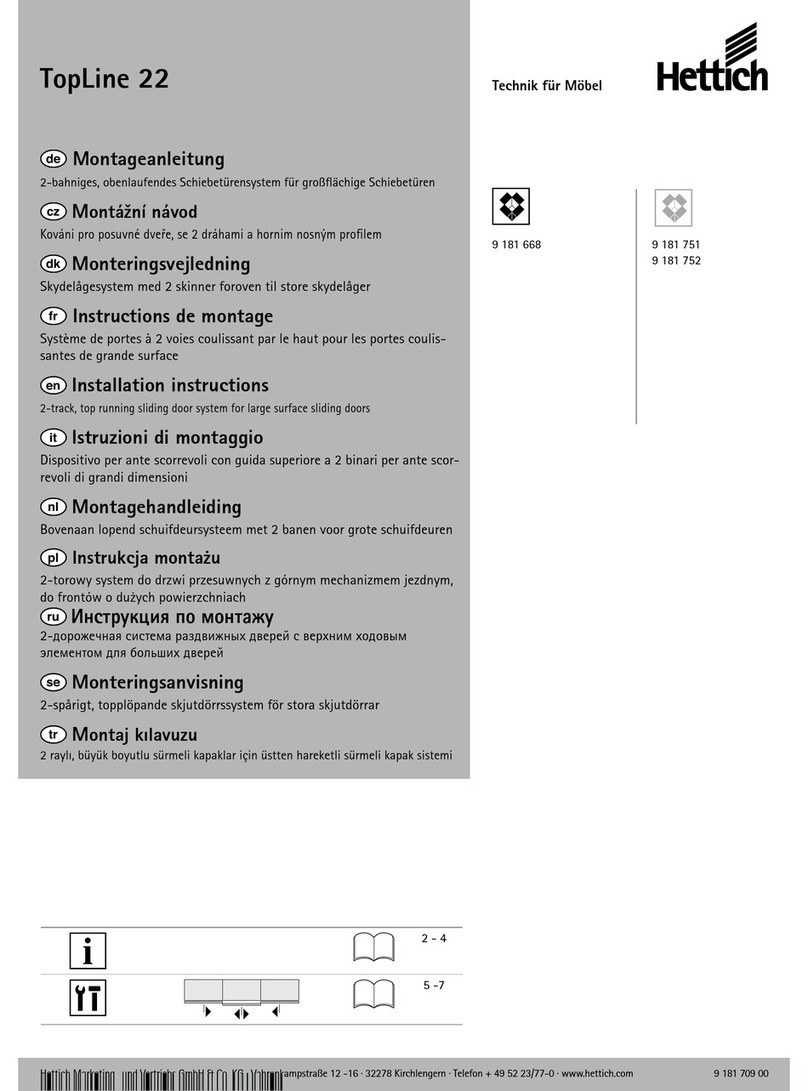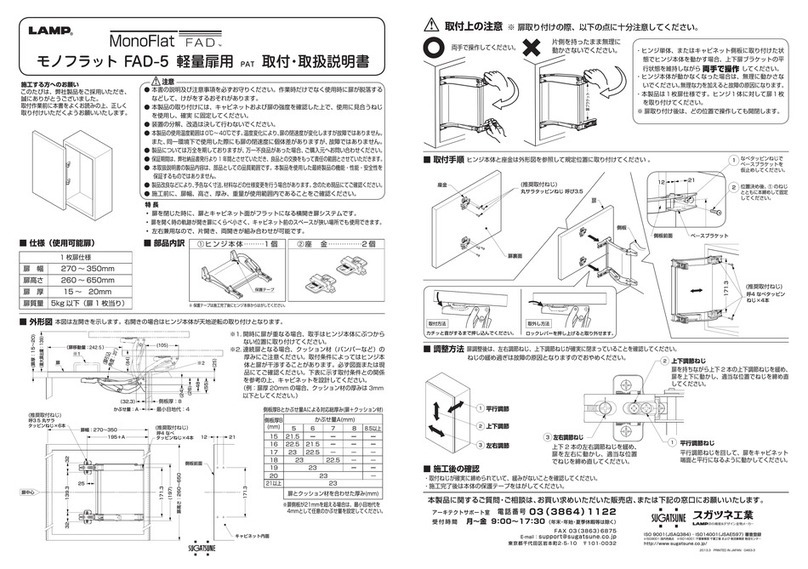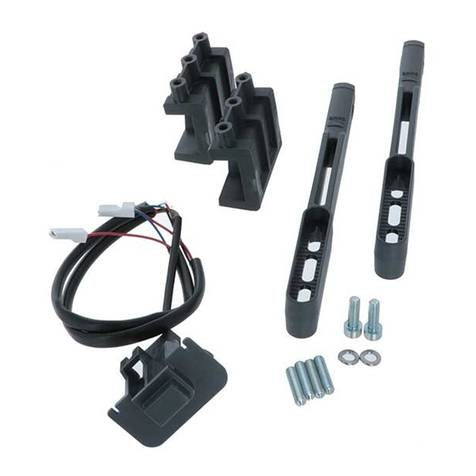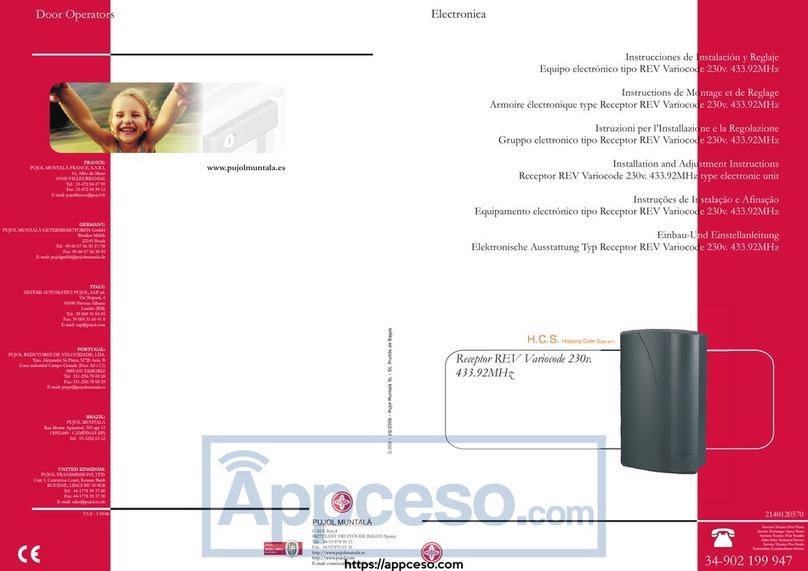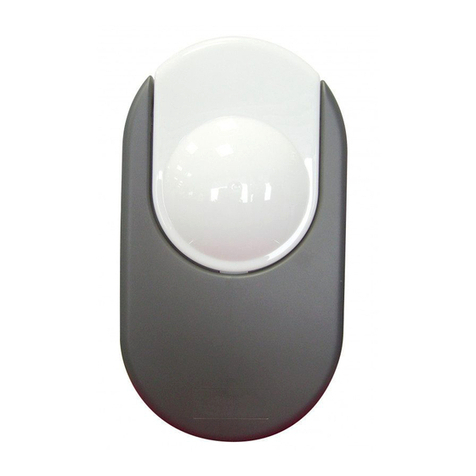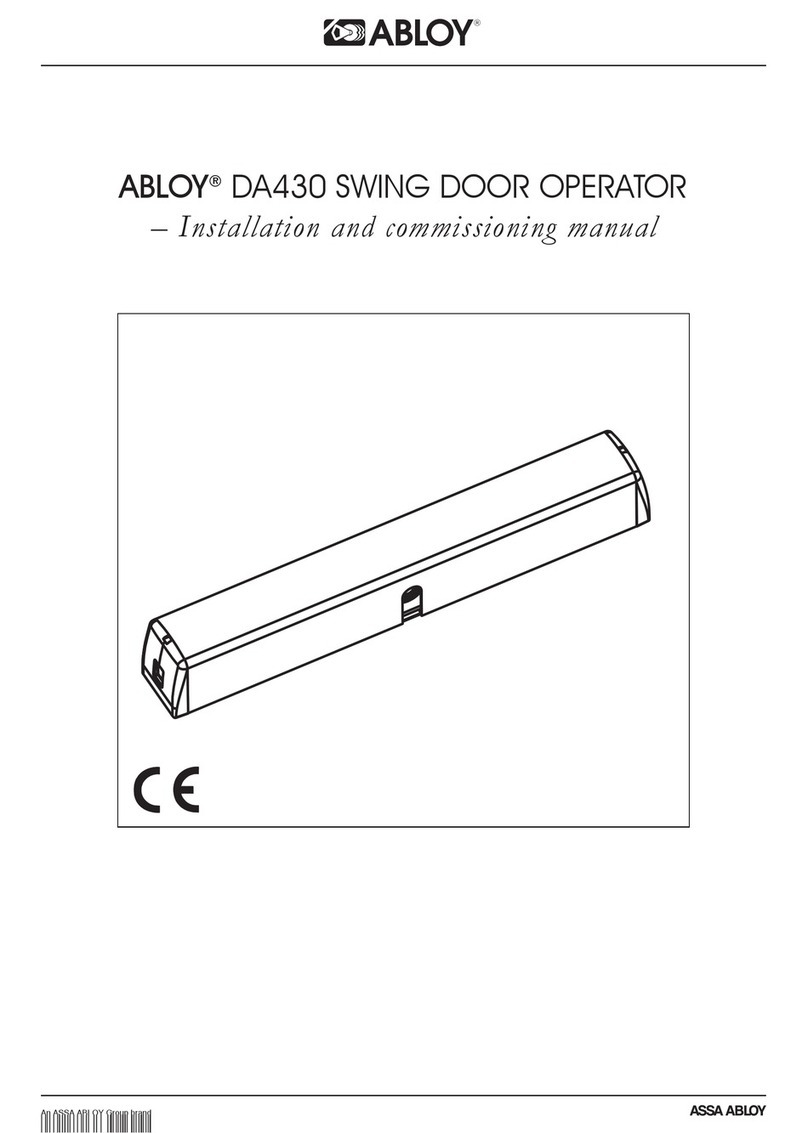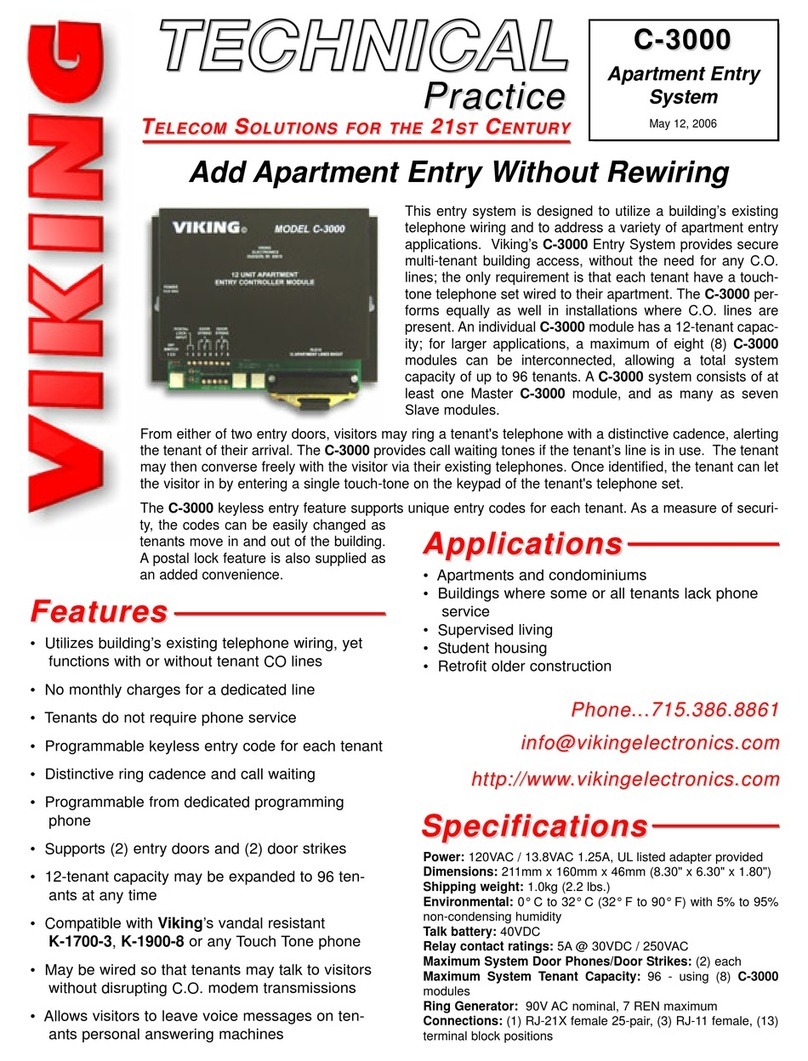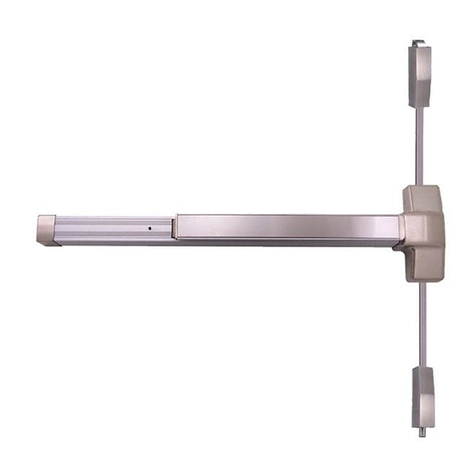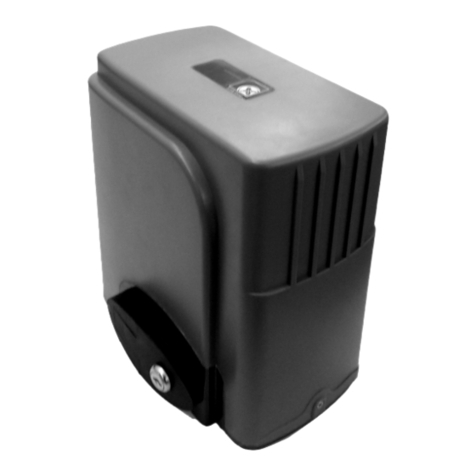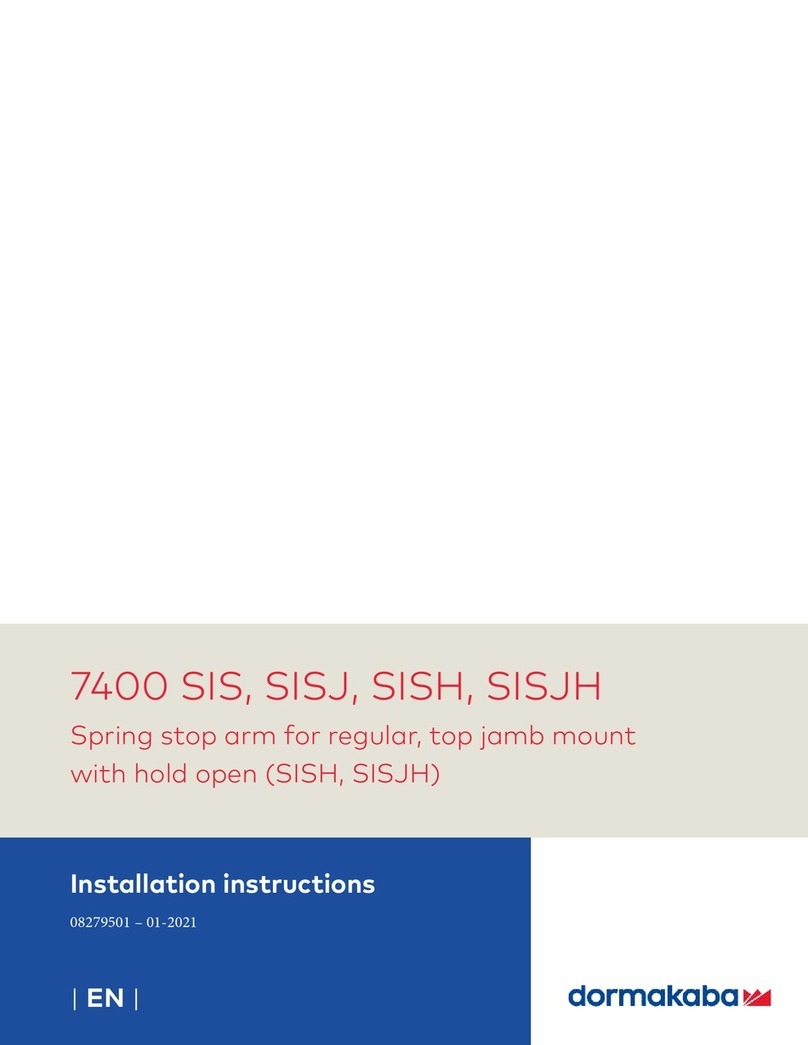Manaras Opera-H Service manual

Installation & Instruction Manual
Installation & Instruction Manual
Commercial & Industrial Heavy Duty Jackshaft Operator
Commercial & Industrial Heavy Duty Jackshaft Operator
(For sectional doors, rolling doors and grilles
(For sectional doors, rolling doors and grilles
Opera-H
Opera-H
(OPH)
(OPH)
Opera-J
Opera-J
(OPJ)
(OPJ)
Opera-HJ
Opera-HJ
(OHJ)
(OHJ)
Opera-SH
Opera-SH
(OSH)
(OSH)
Electro-Mechanical Control
Electro-Mechanical Control
READ AND FOLLOW ALL INS RUC IONS.
SAVE HESE INS RUC IONS.
GIVE O END-USER.
Serial #
Model #
Wiring Diagram #
Project #/Name
Door #/Name
For technical support, please call 1-800-361-2260 or visit www.manaras.com for more information

2
TABLE OF CONTENTS
Installation Instructions............................................................................................................................................... 3
1 General Specifications and Dimensions (OPH / OPJ / OHJ ..............................................................................................................................4
2 General Specifications and Dimensions (OSH ...................................................................................................................................................5
3 Door & Operator Hardware..................................................................................................................................................................................6
3.1 Delivery of Operator..................................................................................................................................................................................6
3.2 Hardware Supplied....................................................................................................................................................................................6
4 Operator Installation.............................................................................................................................................................................................7
4.1 Operator Mounting Options.......................................................................................................................................................................7
4.2 Operator Mounting Holes..........................................................................................................................................................................7
4.3 Sprockets, Spreader Bar and Drive Chain Installation.............................................................................................................................8
5 Operator Control Box...........................................................................................................................................................................................9
6 Manual Hand Chain and Disconnect Chain.......................................................................................................................................................10
6.1 Installation...............................................................................................................................................................................................10
6.2 Operating Mode.......................................................................................................................................................................................11
7 Limit Switches & Limit Cams: Adjustment & Functionality.................................................................................................................................13
7.1 Limit Switch Functionality........................................................................................................................................................................13
7.2 Limit Switch Adjustments: Open and Close Cam Settings.....................................................................................................................13
7.3 Advanced Limit Switch Adjustments.......................................................................................................................................................13
7.4 Limit Switch Adjustment Using Manual Hand Chain (if applicable ........................................................................................................14
7.5 Limit Switch Adjustment Without Manual Hand Chain (if applicable .....................................................................................................14
8 Electrical Wiring.................................................................................................................................................................................................15
8.1 Low Voltage (Controls and High Voltage (Power Connections............................................................................................................16
8.2 Main Power Supply Connection..............................................................................................................................................................16
8.3 Wall-Button Connection...........................................................................................................................................................................17
8.4 Optional Accessory Connections............................................................................................................................................................18
9 Operator Start-up...............................................................................................................................................................................................22
10 Clutch Adjustment..............................................................................................................................................................................................23
11 Electromechanical Circuit Programming (Contactor Circuit .............................................................................................................................24
11.1 Run Mode Settings..................................................................................................................................................................................24
11.2 On Site Modifications..............................................................................................................................................................................25
User Instructions........................................................................................................................................................ 26
1 Quick Fix Instructions.........................................................................................................................................................................................27
Maintenance Instructions........................................................................................................................................... 28
1 Preventative Maintenance Schedule.................................................................................................................................................................28
1.1 Mechanical Inspection.............................................................................................................................................................................28
1.2 Electrical Inspection................................................................................................................................................................................29
1.3 Band Brake Maintenance........................................................................................................................................................................30
2 Troubleshooting Guide.......................................................................................................................................................................................32
3 Electrical Drawings.............................................................................................................................................................................................34
3.1 1 Phase Operator – Hardwired Wiring....................................................................................................................................................34
3.2 3 Phase Operator – Hardwired Wiring....................................................................................................................................................35
3.3 External Wiring – Hardwired...................................................................................................................................................................36
4 Mechanical Exploded Views and Replacement Components...........................................................................................................................37
4.1 Opera Heavy-Duty Jackshaft General View...........................................................................................................................................37
4.2 Opera-H...................................................................................................................................................................................................38
4.3 Opera-J...................................................................................................................................................................................................39
4.4 Opera-HJ.................................................................................................................................................................................................40
4.5 Opera-SH................................................................................................................................................................................................41
4.6 Opera Brake (BRAKE 013 .....................................................................................................................................................................42
4.7 Opera Control Box - Hardwired...............................................................................................................................................................43
4.8 Replacement Motors, Transformers, Solenoids, Relays and Resets.....................................................................................................44
Notes............................................................................................................................................................................ 45
Warranty...................................................................................................................................................................... 47
For technical support, please call 1-800-361-2260 or visit www.manaras.com for more information

3
Installation Instructions
IMPOR AN INS ALLA ION INS RUC IONS
WARNING
TO REDUCE THE RISK OF SEVERE INJURY OR
DEATH TO PERSONS:
1. READ AND FOLLOW ALL INSTALLATION INSTRUCTIONS.
2. Install only on a properly operating and balanced door. A door that is operating
improperly could cause severe injury. Have qualified service personnel make repairs
to cables, spring assemblies and other hardware before installing the operator.
3. Remove all pull ropes and remove, or make inoperative, all locks (unless
mechanically and/or electrically interlocked to the power unit that are connected to
the door before installing the operator.
4. Installation of this door operator must be done by a qualified installer.
5. Verify that the operator is correct for type, size of door and frequency of use per the
operator specifications.
6. Install the door operator at least 8 feet (2,44 m or more above the floor if the operator
has exposed moving parts. Covers or guarding, provided by the manufacturer, must
be installed when the operator is mounted less than 8 feet (2,44 m above the floor.
7. Do not connect the door operator to the source of power until instructed to do so.
8. Locate the control station: (a within sight of the door, (b at a minimum height of
5 feet (1,5 m above floors, landings, steps or any other adjacent walking surface so
small children cannot reach it, and (c away from all moving parts of the door.
9. Install the Entrapment Warning Placard next to the control station in a prominent
location.
10. For products having a manual release, instruct the end user on the operation of the
manual release.
11. If you have any questions about the safety of the door operating system, do not install
the operator, contact Manaras-Opera at 1-800-361-2260.
For technical support, please call 1-800-361-2260 or visit www.manaras.com for more information

4
1 General Specifications and Dimensions (OPH / OPJ / OHJ)
SUPPLY VOLTAGE...............................115, 230 VAC single-phase, 208, 460, 575 VAC three-phase
CONTROL VOLTAGE............................24 VAC class 2 transformer, 2 amp fuse type ACG
MOTOR.................................................Continuous duty 1/2, 3/4, 1 horsepower
OPERATOR OUTPUT SPEED..............41 RPM
NET WEIGHT (Operator only ...............86 Lbs (39 Kg for 1/2HP 115V Opera-H model
STANDARD WIRING TYPE..................C2 (momentary contact to open/stop and constant-pressure-to-close
APPLICATION.......................................Heavy duty for sectional doors, rolling doors and grilles
DUTY.....................................................25 cycles/hour or 100 cycles/day maximum
Table 1 - Operator Selection Guide (OPH / OPJ / OHJ)
Maximum Area in Square Feet (general guideline)
Rolling Doors Sectional Doors
HP Insulated
Steel
16 ga
Steel
Steel Grilles
20 ga
Steel
Alu. Door
22 ga Steel
Alu. Grilles
24 ga
Steel
Steel
18 ga
ins.
Steel
18 ga
20 ga
ins.
Wood
Steel 20 ga,
22 & 24 ga
ins.
Alu. Steel
22 & 24 ga
Fiber
Glass
½157 236 260 319 358 196 245 314 343 392
¾206 294 358 451 515 270 319 441 490 549
1255 358 446 574 613 294 392 490 564 613
For technical support, please call 1-800-361-2260 or visit www.manaras.com for more information
Figure 1 - Opera-H, Opera-J and Opera-HJ Dimen ion

5
2 General Specifications and Dimensions (OSH)
SUPPLY VOLTAGE...............................115, 230 VAC single-phase, 208, 460, 575 VAC three-phase
CONTROL VOLTAGE............................24 VAC class 2 transformer, 2 amp fuse type ACG
MOTOR.................................................Continuous duty 1/2, 3/4, 1 horsepower
OPERATOR OUTPUT SPEED..............41 RPM
NET WEIGHT (Operator only ...............96 Lbs (44 Kg
STANDARD WIRING TYPE..................C2 (momentary contact to open/stop and constant-pressure-to-close
APPLICATION.......................................Ultra high-end heavy duty v-belt drive for sectional doors, rolling doors and
grilles
DUTY.....................................................25 cycles/hour or >100 cycles/day
Table 2 - Operator Selection Guide (OSH)
Maximum Area in Square Feet (general guideline)
Rolling Doors Sectional Doors
HP Insulated
Steel
16 ga
Steel
Steel Grilles
20 ga
Steel
Alu. Door
22 ga Steel
Alu. Grilles
24 ga
Steel
Steel
18 ga
ins.
Steel
18 ga
20 ga
ins.
Wood
Steel 20 ga,
22 & 24 ga
ins.
Alu. Steel
22 & 24 ga
Fiber
Glass
½157 236 260 319 358 196 245 314 343 392
¾206 294 358 451 515 270 319 441 490 549
1255 358 446 574 613 294 392 490 564 613
For technical support, please call 1-800-361-2260 or visit www.manaras.com for more information
Figure 2 - Opera-SH Dimen ion

6
3 Door & Operator Hard are
3.1 Delivery of Operator
Upon delivery of your OPERA jackshaft operator, inspect the unit immediately for any shipping damages. Verify that
you have received all the hardware parts pertaining to your operator model, as listed in Table 3 and shown in
Figure 3. If ordered, other items such as radio controls or other types of optional equipment may be present. If any
item is missing or if there is evidence of damage, call the transport company or your direct supplier.
3.2 Hard are Supplied
Table 3 - Standard Hardware Part Supplied
No Qty Description
1 1 3-Push-button station (open/close/stop
2 1 Operator sprocket (1
Lxxxx
Hxxxx
Gxxxx
3 1 Door sprocket (1
4 1 #41/#50 Drive chain, 4ft (1 (2
5 1 #41/#50 Chain link (1
6 4 5/16-18 x 5/16” Set screw HD1-
HBAG
7 2 Key 1/4” x 1-1/2”
8 1 Pocket wheel hand chain, 24ft (3 (4
9 1 Chain keeper for hand chain (4
10 1 Disconnect chain, 14ft (3 (5
11 1 Chain keeper for disconnect chain (5
12 1 Handle for disconnect chain (5
13 1 Entrapment Warning Placard
NO E: Install the Entrapment Warning Placard (shown in Figure 4 , next to the control station, visible in the area of
the door.
For technical support, please call 1-800-361-2260 or visit www.manaras.com for more information
(1 Differs according to operator model and door characteristics
(2 5ft for 42/54/60 tooth door sprocket, 8ft for 72 tooth door sprocket
(3 Quantity = 2 times door shaft height minus 4ft
(4 Only supplied with OMH/OPH/OHJ/OBH/OSH/OGH/MGH/GH
(5 Only supplied with OMJ/OPJ/OSH/MGH/GH
Figure 3 - Standard Jack haft Hardware
Figure 4 - Entrapment Warning Placard

7
4 Operator Installation
4.1 Operator Mounting Options
The jackshaft operator line has a dual output shaft. These operators may be wall-mounted on either the left hand side
or the right hand side of a sectional door. They can also be hood-mounted, using BRACKET111 (sold separately , or
shelf-mounted on either side of the door.
The standard jackshaft hoist model comes with a chain hoist located on the right of the operator. If the application
requires that the chain hoist be located on the left of the operator (ex: rolling doors, left operator hood mounting , it
must be requested at time of order. Do not attempt to modify the chain hoist yourself.
his operator is not intended to be installed on horizontal slide doors.
Figure 5 - Right Side Wall Mount
(Chain Hoi t on Right)
Figure 6 - Right Side Hood Mount with
BRACKET111 (Chain Hoi t on Right)
4.2 Operator Mounting Holes
CAU ION
The operator has exposed moving parts and to prevent access to the pinch points, the operator must be installed
at least 8 feet (2,44 m or more above the floor. Alternatively, covers or guarding, provided by the manufacturer,
must be installed when the operator is mounted less than 8 feet (2,44 m above the floor.
1. Ensure that the wall or mounting surface provides
adequate support for the operator. The surface must be
rigid enough to prevent any play between the operator
and door shaft. Manaras-Opera recommends the use of
BRACKET111 for hood-mount application.
2. Locate the four mounting holes, as shown in Figure 7.
3. The optimum distance between the door shaft and the
operator drive shaft is between 12" and 15".
4. Secure BRACKET111 to the end bracket of the rolling
door or mount the operator to the wall with 3/8" thru-
bolts. If the wall construction prohibits the use of thru-
bolts, then appropriate and sufficiently sized lag bolts
and anchors may be used.
5. Only tighten the bolts after having adjusted tension of
the drive chain, as shown in section 4.3, p.8.
6. Ensure that the door and operator shafts are parallel.
For technical support, please call 1-800-361-2260 or visit www.manaras.com for more information
Figure 7 - Opera Mounting Hole

8
4.3 Sprockets, Spreader Bar and Drive Chain Installation
The hardware components shown in Figure 8 have been supplied with your operator.
1. Place the door sprocket loosely on the door shaft.
2. Place the operator drive sprocket on the appropriate side of the operator and align it with the drive sprocket of
the operator.
3. Lock the operator and door sprockets in place by inserting the keys and tightening their respective set
screws.
4. Wrap the operator drive chain around the door sprocket and the operator sprocket. Shorten the drive chain to
the appropriate length. Use the chain link to attach the operator drive chain together.
5. Slide the operator to tighten the drive chain and then firmly tighten the mounting bolts.
6. Check the tension on the chain (there should be no more than a 1/4" of slack when the chain is depressed
between the sprockets .
7. Manaras-Opera recommends the use of a chain spreader (sold separately .
For technical support, please call 1-800-361-2260 or visit www.manaras.com for more information
Figure 8 - Hardware Component
Bolt 3/8-16
(To attach chain
spreader
5
Set Screw
Door Sprocket
Spreader Collar
Chain Spreader
Spreader Collar
Operator Sprocket
Key
Key
Drive Chain
Washer 3/8
Lock Washer 3/8
Nut 3/8-16
1
2
3
3
4
6
7
Door Shaft
Operator Shaft

9
5 Operator Control Box
To open the control box cover, loosen the screw at the base of the cover. If the cover cannot be fully opened, the
retaining arm may be used to hold the cover in other positions, see Figure 9.
After installation, allow for proper clearance upon opening the control box cover. If the cover is obstructed from
opening, it is possible to remove the cover by unscrewing it from the box, see Figure 10.
Always close the cover before operating the door.
For technical support, please call 1-800-361-2260 or visit www.manaras.com for more information
Figure 10 - Un crewing Screw from
Control Box Cover
Figure 9 - Open Control Box Cover
Screws
Retaining Arm

10
6 Manual Hand Chain and Disconnect Chain
6.1 Installation
6.1.1 Chain Hoist (Opera-H / SH / HJ)
Before pulling the hand chain through the pocket wheel, pull the limit
cam's retaining bracket back. Turn the cams to the center of the limit
shaft to be sure that they are not being mechanically driven through
their normal limit switch end positions.
1. Run the hand chain through the pocket wheel and through
the chain guide, see Figure 11.
2. Allow both ends of the chain to hang down toward the
ground until both ends are approximately 2 feet (0.6 m from
the floor. Cut the hand chain if necessary.
3. Connect both ends of the hand chain together.
6.1.2 Disconnect Chain (Opera-J / SH)
1. Link the disconnect chain to the hook located at the
extremity of the operator's disconnect mechanism, see
Figure 12.
2. Install the handle under the chain keeper to facilitate
handling of the chain.
3. Under the handle, make a knot in order to fasten the end of
the chain.
6.1.3 Emergency Egress (Opera-HJ)
This operator is built to receive a quick disconnect in case of an
emergency egress.
1. Pass the cable housing (from the emergency egress
control through the holes provided on the frame of the
operator, see Figure 13.
2. Attach the end of the egress cable to the disconnect lever.
3. Secure positioning of the cable housing with two adjustment
collars.
For technical support, please call 1-800-361-2260 or visit www.manaras.com for more information
Figure 12 - Di connect Chain
Chain Keeper
Handle
Disconnect
Mechanism from
Operator
Disconnect Chain
Knot
Figure 11 - Hand Chain In tallation
Figure 13 - Emergency Egre

11
6.2 Operating Mode
6.2.1 Opera-H (Hoist-a-matic® Chain Hoist System)
The automatic emergency chain hoist disconnect mechanism is provided in order to operate the door manually. A floor
level disconnect is not required. In one simple step and by pulling the hand chain in the desired direction, the following
operations may be successfully completed, see Figure 14.
6.2.2 Opera-J
This operator has a floor level disconnect to disconnect the door from the electrical motor and is ready to be manually
operated, see Figure 15.
For technical support, please call 1-800-361-2260 or visit www.manaras.com for more information
Figure 15 - Floor
Level Di connect
Chain
Figure 14 - Hoi t-a-matic®
Pull chain on either side
to operate door.
Follow the 3 steps shown below to
attach the chain (when not in use
to the chain keeper.
Wiggle chain until it
moves freely.
1. Manual Mode 2. Return to Electric Mode 3. Storage
PULL
PULL
STORE
STORE
WIGGLE
WIGGLE
Disconnect Chain
Handle
Chain Keeper
Pull the handle and
attach the
disconnect chain to
the chain keeper for
manual operation.
Release the tension from
the disconnect chain to
return to electrical mode.

12
6.2.3 Opera-HJ
See section 6.2.1 for Chain Hoist Operation or see section 6.1.3 for Direct “on-the-door” Manual Operation.
Activation of the quick disconnect keeps the operator disconnected mechanically and electrically for manual
operation.
6.2.4 Opera-SH
This operator has a floor level hoist engagement lever to:
–disconnect the electrical control of the operator
–release the brake
–engage the manual hoist mechanism, see Figure 16
For technical support, please call 1-800-361-2260 or visit www.manaras.com for more information
Figure 16 - Hoi t Engagement and Hoi t Operation
Pull the handle and
attach the disconnect
chain to the chain
keeper for manual
operation.
Release the tension from
the disconnect chain to
return to electrical mode.
Chain Keeper Disconnect Chain
Handle
2. Manual Mode 3. Storage
PULL
PULL
STORE
STORE
Pull chain on either side
to operate door.
Follow the 3 steps shown below to
attach the chain (when not in use
to the chain keeper.
1. Engagement 4. Return to Electrical Mode

13
7 Limit S itches & Limit Cams: Adjustment & Functionality
WARNING
To reduce risk of SEVERE INJURY or DEATH to persons:
•Do not attempt to make limit switch adjustments unless power has been electrically disconnected.
7.1 Limit S itch Functionality
Open Limit S itch and Advanced Open Limit S itch
When activated, the Open Limit Switch will stop the operator while the door is travelling in the upward direction.
Should be adjusted accordingly to stop door in fully opened position. The Advanced Open Limit Switch is used for a
radio-control feature and to activate the Timer to Close feature (if used .
Close Limit S itch and Advanced Close Limit S itch
When activated, the Close Limit Switch will stop the operator while the door is travelling in the downward direction.
Should be adjusted accordingly to stop door in fully closed position. The Advanced Close Limit Switch is used for the
operation of a reversing edge or external entrapment protection devices. With this limit switch, the floor is not
considered as an obstacle, therefore the door does not reverse its movement once it reaches the floor.
7.2 Limit S itch Adjustments: Open and Close Cam Settings
This operator is equipped with the ACCU-CAM® feature, for precise and quick one-handed limit setting adjustments.
To adjust the limit cams, see Figure 17.
1. Pull the cam's retaining bracket back.
2. Turn the cams for limit adjustment: turning cams toward the center of the limit shaft increases door travel or
turning the cams toward the limit switch decreases door travel.
7.3 Advanced Limit S itch Adjustments
The Advanced Close Limit Switch must be field adjusted in order to deactivate the reversing edge or external
entrapment protection device at a maximum of 6 in (15,2 cm) from the floor. The adjustment can be performed by
changing the position of the Advance Close Limit Switch on its slotted support bracket.
For technical support, please call 1-800-361-2260 or visit www.manaras.com for more information
Figure 17 - Limit Switche and Cam Adju tment
Close Limit
Switch
Advanced Open
Limit Switch
Open Limit
Switch Advanced Close
Limit Switch
Increase
Door ravel
Open Cam Close Cam
Cam Retaining
Bracket
Decrease
Door ravel
Open Side Close Side
Increase
Door ravel

14
7.4 Limit S itch Adjustment Using Manual Hand Chain (if applicable)
Table 4 - Limit Switch Adju tment Procedure
Limit Switch Adjustment Procedures
Open Limit
1. Using the hoist, manually raise the door to a nearly opened position or desired open
position.
2. Pull the cam-retaining bracket from the Open side, see Figure 17, and rotate the Open
cam manually until it activates the Open Limit Switch sufficiently so that a “click” can be
heard.
3. Release cam-retaining bracket and make sure that the bracket engages in the slots of
both cams.
Advanced
Close Limit
1. Using the hoist, manually lower the door to approx. 6” above the ground.
2. Pull the cam-retaining bracket from the Close side, see Figure 17, and rotate Close cam
manually until it activates the Close limit switch sufficiently so that a “click” can be heard.
3. Release cam-retaining bracket and make sure that the bracket engages in the slots of
both cams.
Limit Switch
Fine
Adjustment
1. Limit switch fine adjustment SHOULD be done after the main power supply is connected
to the operator. Refer to section Operator Start-up, Table 6, p.22.
Note: One (1 notch on cam is equal (= to about ½” of the door travel.
7.5 Limit S itch Adjustment Without Manual Hand Chain (if applicable)
Table 5 - Limit Switch Adju tment Procedure (no hoi t)
Limit Switch Adjustment Procedures
Open Limit
1. Move the open cam close to the open limit switch and proceed as per described in section
Operator Start-up, Table 6, p.22.
2. Release cam-retaining bracket and make sure that the bracket engages in the slots of
both cams.
Advanced
Close Limit
1. Pull the disconnect chain for manual operation.
2. Manually open the door approx. 6” above the ground.
3. Pull the cam-retaining bracket from the Close side, see Figure 17, and rotate Close cam
manually until it activates the Close limit switch sufficiently so that a “click” can be heard.
4. Release cam-retaining bracket and make sure that the bracket engages in the slots of
both cams.
Limit Switch
Fine
Adjustment
1. Limit switch fine adjustment SHOULD be done after the main power supply is connected
to the operator. Refer to section Operator Start-up, Table 6, p.22.
Note: One (1 notch on cam is equal (= to about ½” of the door travel.
For technical support, please call 1-800-361-2260 or visit www.manaras.com for more information

15
8 Electrical Wiring
WARNING
To reduce risk of SEVERE INJURY or DEATH to persons:
•All electrical wiring should be done by a qualified professional and in accordance to local
electrical codes.
•Always shut OFF the main power before performing any electrical intervention.
•Use proper wire gauge for incoming power line and for accessory connections.
•Install operator main circuit breaker next to operator for easy access for power shut-off.
•Use separate knockouts on operator control box for accessories and main power cables.
•Always separate low and high voltage wires.
•Operator should be properly grounded to the building ground and to the main power
supply ground lug.
•Always use suitable and appropriate rating circuit breakers for operator protection.
•Compare available power supply voltage to voltage on operator name plate prior to
electrical connection. Failure to connect appropriate power supply voltage may cause
serious damage to the operator.
NO ICE
•THE OPERATOR MUST BE ADEQUATELY PROTECTED AGAINST OVERCURRENT AND SHORT-
CIRCUIT.
•PLEASE REFER TO LOCAL ELECTRICAL CODE.
•PLEASE REFER TO NATIONAL ELECTRIC CODE (NFPA 70 ARTICLE 430 SECTION IV (430,51 /
430,52 / 430,53 .
•PLEASE REFER TO CANADIAN ELECTRIC CODE (CSA 22,1 SECTIONS 28-200 / 28-206.
Guideline to determine the branch-circuit rating of the protective device [A]:
Time Delay Fuse: 1,75 x FLA
Non-Time Delay Fuse: 3,0 x FLA
A fuse that does not exceed the next higher standard ampere rating shall be permitted.
Example: If FLA = 3,8A
•Time Delay Fuse: 1,75 x 3,8A = 6,65A → Standard fuse to use: 10A
•Non-Time Delay Fuse: 3,0 x 3,8A = 11,4A → Standard fuse to use: 15A
For technical support, please call 1-800-361-2260 or visit www.manaras.com for more information
FLA = Full Load Amp

16
NO ICE
•The installer MUST test for proper connection and functionality of the operator and its accessories
before leaving the job site.
•The installer should also perform a demonstration for the end-user.
8.1 Lo Voltage (Controls) and High Voltage (Po er) Connections
1. Route the power line wire from the
right of the control box, as shown in
Figure 18.
2. Route all low voltage control wires
from the left of the control box, as
shown in Figure 18. KEEP LOW
VOLTAGE WIRES SEPARATE FROM
LINE VOLTAGE WIRES.
3. USE COPPER CONDUCTORS ONLY.
8.2 Main Po er Supply Connection
Single-Phase (115/230V) hree-Phase (208/230-460-575V)
Correct motor rotation: Switch the BLUE and ORANGE
motor wires on the contactor.
Correct motor rotation: Switch ANY TWO incoming lines
(phase on the power terminal block.
For technical support, please call 1-800-361-2260 or visit www.manaras.com for more information
Figure 18 - Low Voltage (Control )
and High Voltage (Power)
Connection
Line 1
Line 2
Line 3
Ground Lug
Power Terminal Block
NEUTRAL
LIVE
Power Terminal Block
PowerControl
Ground Lug

17
8.3 Wall-Button Connection
WARNING
•Wall controls must be mounted in clear view of the door, far enough from the door, or positioned such
that the user is prevented from coming in contact with the door while operating the controls and at least
5 feet (1,5 m above the standing surface.
•Keep low voltage wires separate from line voltage wires.
•Use copper conductors only.
Push-Button Station (PBS) Connection
Figure 19 - STATION 020 / 084
3-PBS Open / Clo e / Stop
Figure 20 - STATION 041 / 049 / 056 / 076 / 078
3-PBS Open / Clo e / Stop
Figure 21 - STATION 079
3-PBS Open / Clo e / Stop with Key Lock-out
Figure 22 - STATION 080
3-PBS Open / Clo e / Stop with Key Lock-out and Light
Figure 23 - STATION 001 / 081
1-PBS Open
Figure 24 - STATION 010 / 082
2-PBS Open / Clo e
For technical support, please call 1-800-361-2260 or visit www.manaras.com for more information
3
OPEN
CLOSE
STOP
4
5
2
OPEN
CLOSE
STOP
COM
OPEN
(OUVERTURE
CLOSE
(FERMETURE
STOP
(ARRÊT
Link (Lier
Open/Close/Stop
OPEN
CLOSE
COM
STOP
OPEN
(OUVERTURE
CLOSE
(FERMETURE
4
5
2
3
NO 3
4
NO 3
4
NC 1
2
STOP
(ARRÊT
Link (Lier
Open/Close/Stop
OPEN
CLOSE
COM
STOP
OPEN
(OUVERTURE
CLOSE
(FERMETURE
KEY
(CLÉ
4
5
3
2
NO 3
4
NO 3
4
NC 1
2
NO 3
4
Link (Lier
Open/Close/Stop
OPEN
CLOSE
COM
STOP
OPEN
(OUVERTURE
CLOSE
(FERMETURE
KEY
(CLÉ
4
5
3
2
NO 3
4
NO 3
4
NC 1
2
NO 3
4LED
1
9
24 VAC
24 VAC
OPEN
COM
OPEN
(OUVERTURE
4
3
NO 3
4
Link (Lier
Open/Close
OPEN
CLOSE
COM
OPEN
(OUVERTURE
CLOSE
(FERMETURE
4
5
3
NO 3
4
NO 3
4

18
8.4 Optional Accessory Connections
NO ICE
•Photo cells must be installed facing each other across the door's path within 6” (15 cm of the plane of
the door and the beam no more than 5-3/4” (14,6 cm above the floor.
•Keep low voltage wires separate from line voltage wires.
•Use copper conductors only.
8.4.1 Electric Photo Cells / Photo Eyes (Non-Monitored)
Through Beam Type
Figure 25 - PHOTO 008 Figure 26 - PHOTO 015 / 016 / 045 / 050 / 051 / 059
Reflective Type
Figure 27 - PHOTO 018 Figure 28 - PHOTO 038
Figure 29 - PHOTO 060
For technical support, please call 1-800-361-2260 or visit www.manaras.com for more information
1
96
3
Always set the jumper located
inside the Interface Module on
N.O. (Normally Open
ALIGNMENT
BLACK & WHITE
TRANSMITTER
RECEIVER
BLACK
TK-8200
Interface Module
POWER BEAM RELAY
OUT
1 2 3 4 5 6
NO NC
JMP
24VAC
24VAC
COM
SAFETY
BLACK & WHITE
BLACK
3
1
9
6
24VAC
COM
SAFETY
RX
42 3 51
Pwr
Com
NO
NC
Pwr
1 2
Pwr
Pwr
TX
24VAC
C1 [1]
3
1
9
SAFETY
COM
24VAC
24VAC
6
NO1 [2]
NC1 [3]
NC2 [4]
NO2 [5]
C2 [6]
P
P
BLUE
BROWN
ORANGE (COM
BLACK (NO
(NOT USED
WHITE (NC
3
1
9
SAFETY
COM
24VAC
24VAC
6

19
8.4.2 Reversing Edge Device (Non-Monitored)
NO ICE
•If the door is controlled by any device other than a constant pressure push-button station on close,
including a timer-to-close, a reversing edge must be connected.
Installation
Pneumatic Sensing Edge
1. Place the air switch in position, refer to Figure
30.
2. Place the air hose in position.
3. Use a coil cord or take-up reel to connect the air
switch to the operator terminals. Install electric
wires according to Figure 31 or Figure 32.
4. Connect one end of the air hose to the air
switch.
5. Place the air plug in the other end of the air
hose.
Electric Sensing Edge
1. Place the junction box in position, refer to Figure 30.
2. Place the sensing edge in position.
3. Use a coil cord or take-up reel to connect the
sensing edge wires to the operator terminals.
Install electric wires according to Figure 33.
4. Connect the sensing edge to the junction box.
5. N/A
Figure 31 - AIRSWITCH 001 / 007
Figure 32 - AIRSWITCH 009
Figure 33 - Electric Rever ing Edge
For technical support, please call 1-800-361-2260 or visit www.manaras.com for more information
RED
YELLOW (NO
Adjustment screw
(Vis d'ajustement
3
6
COM
SAFETY
WHITE
GREEN (NO
3
6
COM
SAFETY
3
6
COM
SAFETY
2-Wire Edge
Figure 30 - Rever ing Edge
1
2
3
45
3

20
8.4.3 Pull Cord & Key S itch
Figure 34 - PULLCORD 001 / 003 / 004 / 007
Figure 35 - KEYSWITCH 010 / 015 Figure 36 - KEYSWITCH 019
For technical support, please call 1-800-361-2260 or visit www.manaras.com for more information
3
8
4
O/C
For OPEN only
N.O. COM
COM
OR (OU
(Seulement pour OUVERTURE
NO
COM
NO
COM
CLOSE
OPEN
COM
5
4
3
Place a jumper between
#8 & #9 on the board
(Installer un cavalier entre
#8 & #9 sur la plaquette
NO
COM
NO
COM
2
COM
STOP
3
4
5
CLOSE
OPEN
STOP BUTTON
2-Position Key S itch 2-Position Key S itch & Stop Button
Recommendation: Put Control Board on C2
or E2 Mode (constant-pressure-to-close
This manual suits for next models
7
Table of contents
Other Manaras Door Opening System manuals
